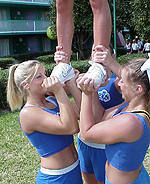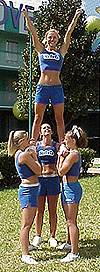| HOME |
| SCHEDULES |
| SQUAD PICTURES |
| TIPS & TECHNIQUES |
 |
 |
 |
 |
 |
 |
 |
 |
 |
 |
| TIPS & TECHNIQUES (remember, all stunts should be practiced under the supervision of a qualified coach or advisor!) DOUBLE TAKE TECHNIQUE One of the most basic elevator transitions is the double take. This transition must be learned before going on to more diffi- cult transitions (such as the 360 elevator), that require the double take technique to execute. Begin in a normal elevator position with 2 bases, a back spot, and a flyer. On a designated count (one, two..), the bases and back spot take a slight dip to get their timing together, and then raise the flyer's feet to eye level before lowering the flyer back to the initial loading position for the elevator. The bases feet should be shoulder width apart, backs straight, and they should be squeezing in their elbows while creating a 90 degree angle with their arms holding the flyer's feet. When the flyer hears the count, she stays tight while the bases take the timing dip, pulling up with her shoulders as they raise her to eye level and then spots for the bases shoulders, keeping her hips up, as they lower her into the loading position. The flyer catches herself on the bases shoulders. Once in the loading position, the flyer has no weight in her feet. She is completely supporting herself. The spotter begins holding the ankles of the flyer. She takes the timing dip with the bases and then lets go to reach as high as she can to make contact with the seat of the flyer so she can begin to slow her down into the loading position. From the loading position, the bases drive with their legs and the flyer pushes off with her arms back to the initial elevator postion. Once you've mastered the basic elevator to elevator double take transition, move on to elevator to extension, then extension to elevator, and, eventually, extension to extension. This technique is the foundation of all major transitions. - VARSITY.COM , JUNE 2002 |
 |
 |
 |
 |
 |
